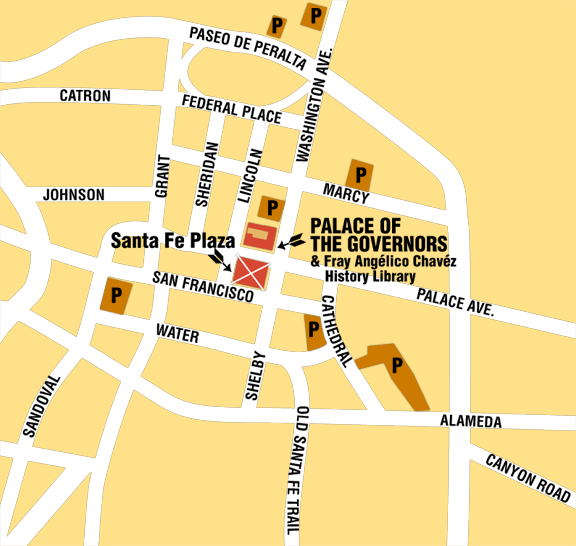The Palace of the Governors

Santa Fe during the 1600’s
Santa Fe, the third oldest city in the country, was founded in the early 1600’s. The Spanish explorers of the time conquered this area and missionaries began efforts to Christianize the Pueblo communities living nearby. Under Spanish command Pueblo people were slaughtered or enslaved as the explorers came to establish a new colony. During this time Pedro de Peralta was appointed as the second Spanish governor in 1610. Under rule the construction of the palace–one of the oldest capital buildings in the country–began.1

Historical Significance:
This historic site served as the seat of the government for the Spanish colony of Nuevo Mexico. When the United States annexed New Mexico in 1846, the Palace of the Governors served as the first territorial capitol for the following 40 years. This building has survived many significant events such as the Pueblo Revolt, the Spanish reconquest, and the American Civil War. This site is also located along the historic Santa Fe Trail.
The Pueblo Revolt of 1680-1693:
In 1680 Pueblo Indians grew tired of the forced labor and religious persecution imposed on them by Spanish authorities. Led by a medicine man named Pope they planned an attack. Spanish troops resisted the attack by gathering in the Palace of the Governors for ten days, but the Pueblos eventually cut off the water supply and forced the Spaniards to retreat to El Paso. The Pueblo people than took over the palace for the next twelve years and dramatically changed its interior to remove traces of Spanish culture. The palace was eventually taken back by the Spaniards, led by Diego De Vargas who was the governor in 1693.2
The Palace Structure and Geography
The Palace of the Governors is an old-style adobe building that included many features important to the Spanish conquistadors. Inside the palace there were private apartments for the governors, official reception rooms, offices, military barracks, stables, and servants’ quarters. There is a chapel inside the building that was used for private prayer and masses. Outside there were vegetable gardens planted on ten acres of land. The western part of the building served as a prison and a storage for the gun powder.3

The New Mexico History Museum
The New Mexico History Museum is just catty-corner from the Palace of the Governors and was built as a companion to the historical site. This museum includes exhibitions that show the history of American Indians, Spanish colonization, the Mexican Period, and travel and commerce on the legendary Santa Fe Trail. This museum adds to the physical space of the historic area near the Santa Fe Plaza.4
The Palace of the Governors Today
Today, the Palace is strictly a museum occupying a prominent place on the north side of the plaza. Renovations to transform the building into a museum started in 1913 with a goal of highlighting the structure’s Spanish Colonial styling. The city of Santa Fe wanted to preserve the history that the palace held, but also make it appeal to tourists. They succeeded tremendously, and it remains a premier destination for those seeking insight into the origins of the American Southwest.3

Bibliography
- Abbink, Emily. New Mexico’s Palace of the Governors: History of an American Treasure. Museum of New Mexico Press, 2007.
- “History of Santa Fe, New Mexico.” www.u-s-history.com/pages/h2117.html.
- New Mexico History Museum, www.nmhistorymuseum.org/campus.php
- “Palace of the Governors.” Historic Santa Fe Foundation, www.historicsantafe.org/palace-of-the-governors.